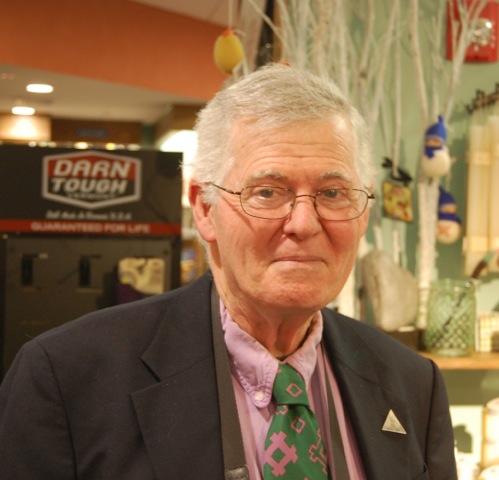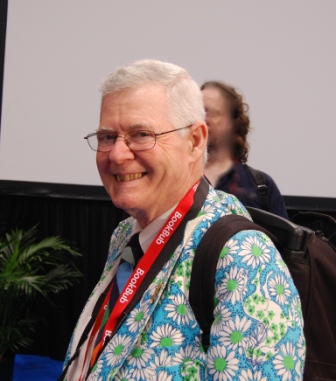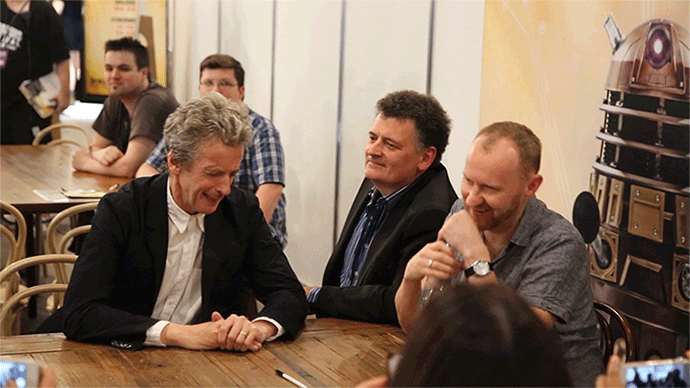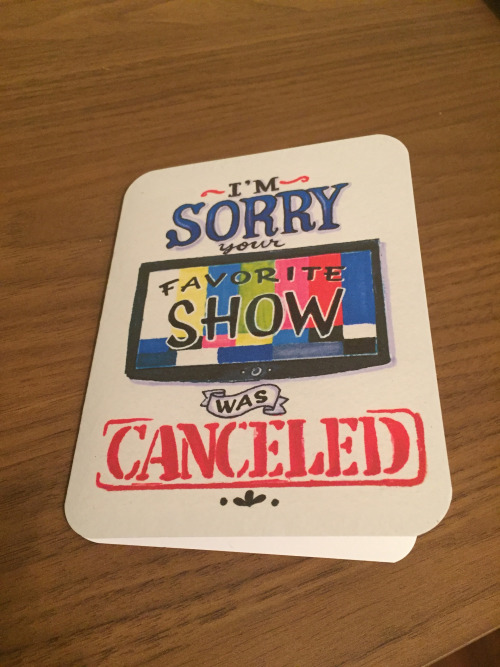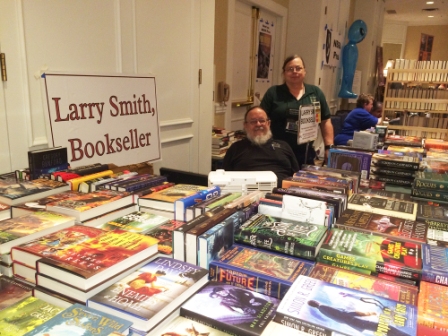(1) RULES OF FASHION. Mary Robinette Kowal knows the inside story about “David Hartwell’s sartorial splendor 1941-2016”.
David was a fashion junkie. I know– I know exactly what you’re thinking. That a man who would wear paisley and pinstripes is not an example of sartorial sense. But wait. He collected haute couture pieces. Those jackets, terrifying ties, shirts, and trousers had been the height of fashion when it was produced.
He might spend years tracking one down. Often, he was wearing them in combinations that the designer had actually intended. When I saw him at conventions after that, we didn’t talk fiction. He would tell me the story behind whatever pieces he was wearing and talk about the designer and the theory behind why this particular combination had been fashionable in its day. He wasn’t buying clothes because they were tacky; he was buying them because he was enjoying this whole meta-conversation about fashion and taste.
(2) YOUR OWN SPACESHIP. SF Signal’s new Mind Meld, curated by Paul Weimer, poses these questions —
Q: Congratulations. You can take a trip on, or if you prefer, captaincy of, the spacecraft of your own choice from genre literature. The only catch is–it can’t be the Millennium Falcon or the Firefly. Rey and Mal refused to give up their ships. What spacecraft would you want to own, or travel on? Why?
The answers come from Amanda Bridgeman, K.V. Johansen, Jay Garmon, Alexandra Pierce, Julia Rios, Joshua Bilmes, Josh Vogt, Brenda Cooper, Jacey Bedford, Laurel Amberdine, L. M. Myles, and Angela Mitchell.
(3) ONE CREEPY LANE. J.J. Abrams is a busy man. His movie 10 Cloverfield Lane is coming to theatres March 11. Esquire writer Michael Sebastian summarizes what the trailer reveals about its story.
The movie stars John Goodman, whose character is living in a bunker with what appears to be his family. There’s a nostalgic sheen to the setting, and it’s reminiscent of the hatch in the Abrams co-created TV show Lost. It’s unclear whether they’re stuck in the bunker because of what happens in Cloverfield, when a giant monster wreaks havoc on New York City. The movie is told through what is said to be found footage of the disaster.
(4) HUGO RULES IDEA. Jonathan Cowie’s solution for what he feels is broken in the Best Dramatic Presentation Short Form category is, ironically, to undo the change that was made to fix the category in the first place, and go back to voting for series as a whole.
A possible suggested solution? My suggestion actually would not impact on Hugo nominators and voters in any way! As far as they would be concerned they would carry on nominating and voting on the short-list in the usual way as if nothing had changed. But what would change would be the way the nominations were treated: both the series and the episode titles would be counted differently.
Here, with nominations, a nominator could nominated episodes from five separate series or, at the other end of the extreme, for five episodes from the same series, or any mix in-between just as nominators can do now. (And ‘yes’, I know that the nominating rules are about to change but for now I want to keep this simple.) The change would be in the way these nominations were counted. Nominators would get just one vote per series they nominate. This means that if you voted for four episodes of Star Trek and one of Tripped then that would only count for one vote each for Star Trek and Tripped (two series votes — one for Star Trek and one for Tripped — even though four episodes of Star Trek were nominated). At this first nomination stage we would only be considering series (not episodes). In this specific way the series with the most votes would get on the short-list ballot with nominators effectively getting just one vote per series they nominate. Ignoring episode titles at this stage, and considering only series (be they TV or web series or even short films), would ensure that the ballot had on it a list of different series with no duplicates. In other words all the series on the ballot would reflect the numbers of people nominating series (and not, as is now, the numbers nominating different episodes of the same series).
Then, with the next stage of finalising the shortlist would come the individual episode part. At this stage we have just a list of series and an episode title needs to be associated with each. However some series may have had more than one episode nominated. Here, all those that nominated for series on the short-list would have their nominations for all their individual episode titles counted: again, one vote per episode title. And so, to continue with our example, all our nominator’s four Star Trek episodes would all be counted and each episode title get one vote. Of all the nomination forms submitted, the individual episode with the most nominations for any single series is the one that gets on the ballot.
This would mean that the Hugo for Dramatic Presentation Short Form nominations would better reflect the diversity of televisual SF that exists with a range of different series always ending up being on the short-list final ballot and then with the most popular episode at the nomination stage associated with each one.
(5) KUSHNER REMEMBERS. So many fine reminiscences about David Hartwell are being posted. Here is an excerpt from Ellen Kushner’s:
I quit that job to write my first novel. When I finished Swordspoint, no one in the field would touch it but David. While my agent tried selling it mainstream, David said he would be there waiting (then at Arbor House) if that failed. I joked that it was just his revenge on me for quitting on him – to get me back in his clutches – but they were fine clutches to be in. He made sure my little ms. was read by the likes of Samuel R. Delany, and he proudly told me he was getting me a Thomas Canty cover, knowing that was my ultimate dream…
(6) DONATIONS REQUESTED. Kathryn Cramer, grateful for the care David Hartwell was given at a local hospital, asks people to make a contribution —
Though David was on a respirator for an extended period of time, Elizabethtown Community Hospital in Elizabethtown, NY does not have a mechanical respirator of its own. A wonderful nurse whose name I didn’t catch or have forgotten spent FIVE HOURS, yes FIVE FUCKING HOURS, compressing a blue rubber bulb that substituted for the action of David’s diaphragm. They took wonderful, compassionate care of him, and this is not a complaint about the service.
Rather, if you are thinking of David tonight and wish you could have done something, please follow THIS LINK http://www.ech.org/make-a-contribution.html and make a donation earmarked to buy ECH its own mechanical respirator.
ECH is a small, rural hospital. They do not own their own respirator. Rather, there is a shared one that travels from one facility to another.
David did not die for lack of a respirator. Nothing could have saved him. But please, as you think of him this evening, think not just of David, but of the matter of the nurse who was his lungs Tuesday night. I am deeply grateful to her. But what she did should not have been needed.
Based on my experience of the past few days, it is my considered opinion that NO HOSPITAL IN AMERICA SHOULD BE WITHOUT ITS OWN RESPIRATOR.
This is the 21st century. We can do this.
(7) IS COSPLAY IMPERILED? The lawsuit is about copyright protection for cheerleading uniforms, however, Public Knowledge in “Cosplay Goes to the Supreme Court” says the decision could have consequences for recreation costumers. Truth or clickbait?
Yes, you read that right: the Supreme Court of the United States may get to decide the legal status of all those Jedi robes you’ve got squirreled away. The Supreme Court is considering a case that will set the standard for when clothing and costume designs can be covered by copyright—and when people who mimic them (such as costumers) can be sued for potentially enormous damages.
The parties to the case, Star Athletica and Varsity Brands, both design cheerleading uniforms. Varsity claims that major portions of their designs are entitled to copyright protection, while Star Athletica points out (and is backed up by a long line of caselaw) that clothing designs are explicitly exempted from copyright. Their arguments rest on different interpretations of a legal concept known as “separability”—a topic so abstract and murky that even seasoned copyright lawyers avoid it.
To understand the case and its impact, you need to keep in mind two things. First, copyright protects creative works. It does not protect what it calls “useful articles,” or items which are designed purely for utility. Copyright protects a statue; it does not protect the chisel….
All of which brings us back to cosplay. If the Supreme Court decides on a test that gives a lot of leeway for “original” designers to sue others for infringing on the “look” of their clothing, costumers are left right in the crosshairs. And copyright damages can be positively massive, running up thousands of dollars per infringement. Public Knowledge will be filing in support of Star Athletica’s petition before the Supreme Court, highlighting the scope of hobbyists and consumers that the ruling could impact.
(8) TERMINATED. Don’t be looking for a second Terminator 2. Be happy with the one you had. Yahoo! Movies explains, “A Sequel To ‘Terminator Genisys’ Is Likely Dead In The Water, But That’s Okay”.
Hollywood loves reboots and prequels so much right now that they want them to make love and create preboots. Yes, preboots. Something to kickstart cash cows back into delivering that sweet sweet franchise milk. Prometheus is kind of a good preboot, X-Men: First Class was great, but Terminator: Genisys was the motion picture equivalent of Budnick holding onto your waist and spending your arcade cash (except more confusing). That’s probably why the sequel to the prequel reboot (presequeboot?) that was unfathomably titled Terminator 2, has been removed from Paramount’s release calendar.
(9) ELLISON VOICES GAME. The game originally created in 1995 can now be played on a phone. “I Have no Mouth, and I Must Scream is now on mobile” reports Jeffrey Matulef on Eurogamer.net.
Based around the Harlan Ellison short story of the same name, I Have no Mouth, and I Must Scream is set in a post-apocalyptic world where the last five humans are immortal and forever tortured by a supercomputer that wiped out humanity 109 years ago. You play as all five survivors as they confront the various psychological and physical tortures bestowed upon them by their sadistic, sentient captor.
You can play each chapter in any order and there are multiple endings available. You can also change the graphics and sound by choosing different audio and visual filters and new touch-based control inputs are available as well….
This time out Night Dive, who now owns the rights to the game, joined forces with mobile porting company DotEmu, who previously ported Another World: 20th Anniversary Edition, The Last Express and Double Dragon Trilogy.
I Have no Mouth, and I Must Scream costs £2.99 / $3.99 on iOS and Android.
Game play is reviewed in this video from Monsters of the Week by RagnarRox.
(10) ASIMOV ANALOGY. New Republic contributor Jeet Heer, who was quoted here in a Hugo roundup last year, has worked a classic sf reference into his recent speculation about Trump’s appeal within his own party.
Trump, on the other hand, is so anomalous a figure that the GOP establishment can console themselves with the knowledge that he leads no faction. Even if he wins the nomination, Trump can be safely relegated to the category of a one-off, a freak mutation, never to be repeated. Trump would be like the character The Mule, in Isaac Asimov’s Foundation novels. In the schema of Asimov’s far future science-fiction series, The Mule is a galactic conquerer who throws history off the course that it was expected to take, but the changes he introduces are ultimately minor because he has no successor.
(11) TODAY IN HISTORY
- January 21, 1789 – The first American novel, The Power of Sympathy, is published in Boston. (Apparently it wasn’t banned in Boston – think how much that would have helped sales.)
(12) TODAY’S BIRTHDAY BOY
- Born January 21, 1938 – Robert “Wolfman Jack” Smith. My friend, “Imponderables” author David Feldman, ran Wolfman Jack’s campaign for president, once upon a time.
(13) LOCAL FOSSIL MAKES GOOD. I’m a bit skeptical about the idea of a “Welsh dinosaur” – especially one that avoided being turned into coal. But the BBC feels perfectly comfortable writing headlines like “Welsh dinosaur named ‘dragon thief’”.
A 201-million-year-old dinosaur that fell out of a cliff face at Penarth in South Wales in 2014 has been formally named as Dracoraptor hanigani.
Loosely translated, the Dracoraptor part means “dragon thief”; hanigani honours Rob and Nick Hanigan – the two fossil-hunting brothers who found it.
In a new analysis, scientists say the specimen is possibly the oldest known Jurassic dinosaur from the UK.
(14) PUN CONTENT WARNING. Fresh from reading about the Puppy characterization of Damien G. Walter’s grant, James H. Burns saw that Blackpool is to stage a ‘reimagining’ of the King Kong story, thanks to a £680,000 Arts Council grant and wondered if it was bananas to think this means King Kong is on the Dole…
He’ll be here all week, folks.
(15) OTHER MONKEY BUSINESS. The very last thing in Eric Robert Nolan’s “Throwback Thursday: Weird 1970’s ‘Planet of the Apes’ merchandise” is a book cover identifying Jerry Pournelle as the author of the novelization Escape From The Planet of the Apes. How did we forget that?
Finally, pictured below is a novelization of one of the movie’s sequels, “Escape From the Planet of the Apes” (1971). I think I saw this among the disheveled paperback library that always occupied the back seat and back floor of my Dad’s car. I saw Boulle’s source novel in that back seat once, with a weird minimalist art cover. My Dad explained that it was “very different from the movie.” Or I might have seen it on the floor of the closet I shared with my brother. (That closet functioned according to trickle-down economics — the really cool stuff occasionally fell from his top shelf to the floor where I could grab it.)
(16) A LITTLE LIST. No, I am not going to be linking to many more of these, or really, any more of these, but I laughed when I saw Luther M. Siler’s headline – “Oh, why not: #Hugo awards eligibility post”.
Rumor has it that Hugo nominations are going to open up next week, and I have two– count ’em, two! different works that will be eligible for nomination.
(Yes, indie authors are eligible. I checked.)
(17) ASPIRING SPACE TAILOR. Adam Savage has been talking recently about his desire to make one of the spacesuits from The Martian to add to his costume collection. And he convinced Fox to loan him one to take a look at first.
(18) ZOOLANDER/MOONRAKER MASHUP? It’s not just Adam Savage who wants to wear a spacesuit. In “To infinity and beyond: how space chic is ready for blast off”, The Guardian says all kinds of fashion designers are returning to 2001 — the film, that is.
At the men’s shows in Milan last week, astronauts appeared almost as often on the catwalk as the inevitable Bowie tributes. Versace produced a show dedicated, as Donatella said, to the future. The mood – all shiny white plastic – felt very 2001 (the film, not the year), especially when the show began with models running around the darkened catwalk in bright fibre-optic outfits, like those training for a mission. When the lights went up, Versace’s idea of an astronaut was earthbound, slick and boardroom-ready, probably with important financial reports rather than space food in his backpack-cum-jetpack. He wore a silver mac, or chunky bright white trousers and matching biker jackets, a bit like the fashion version of Buzz Lightyear’s outfit. A cropped leather jacket with Versace’s version of Nasa badges was another highlight of haute astronaut style.
One outfit in the accompanying photos has enough decorative pins on it to be Radch haut-couture.
(19) BINKS RECLAIMED. Chris Hallbeck’s Maximumble comic for January 21 has a new use for Jar-Jar Binks.
And after you read the comic, you’ll understand why it makes me think of this routine by Lily Singh –
[Thanks to Alan Baumler, Will R., Glenn Hauman, Lorcan Nagle, James H. Burns, and John King Tarpinian for some of these stories. Title credit goes to File 770 contributing editor of the day IanP.]


